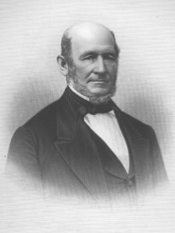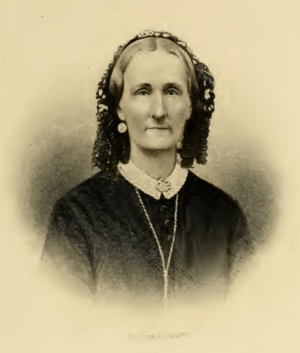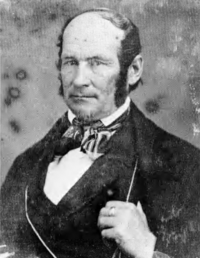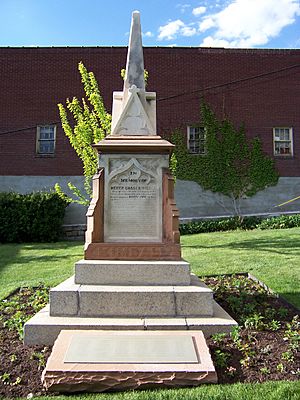Heber C. Kimball facts for kids
Quick facts for kids Heber C. Kimball |
|
|---|---|
 |
|
| First Counselor in the First Presidency | |
| December 27, 1847 – June 22, 1868 | |
| Quorum of the Twelve Apostles | |
| February 14, 1835 – December 27, 1847 | |
| End reason | Called as First Counselor in the First Presidency |
| LDS Church Apostle | |
| February 14, 1835 – June 22, 1868 | |
| Reason | Initial organization of Quorum of the Twelve |
| Reorganization at end of term |
No apostles ordained |
| Personal details | |
| Born | Heber Chase Kimball June 14, 1801 Sheldon, Vermont, U.S. |
| Died | June 22, 1868 (aged 67) Salt Lake City, Utah Territory, U.S. |
| Signature | |
Heber Chase Kimball (born June 14, 1801 – died June 22, 1868) was an important leader in the early Latter Day Saint movement. He was one of the first twelve apostles in the early Church of the Latter Day Saints. He also served as a top advisor to Brigham Young in the First Presidency of the Church of Jesus Christ of Latter-day Saints (LDS Church). He held this role for over twenty years, from 1847 until he passed away.
Kimball agreed to practice plural marriage, which was part of the church's beliefs at the time. He eventually married 43 women. Some of these marriages were for caretaking, meaning he helped provide for them. He had a total of 66 children with 17 of his wives.
Contents
Early Life and Family
Heber Chase Kimball was born on June 14, 1801, in Sheldon, Vermont. His family had come to Massachusetts from England in the 1600s. He was named after a judge who had helped his family. His father, Solomon F. Kimball, was a blacksmith and farmer.
Around 1811, his family moved to West Bloomfield, New York. This happened because his father lost money due to a trade ban before the War of 1812.
Education and Early Work
Kimball left school when he was 14 years old. He learned to be a blacksmith and a potter. Around 1820, he moved with his brother to Mendon, New York. There, in November 1822, he married his first wife, Vilate Murray.
For the next ten years, he worked as a potter. He bought land, built a house and barn, and planted fruit trees.
Family Life and Challenges
Sadly, several of Kimball's close family members died from tuberculosis within a few years. His mother passed away in 1824, and his father in 1826. His brother Charles and his wife also died shortly after.
His son William Henry was born in 1826. He was Kimball's first child to live past infancy. His daughter Helen Mar was born in 1828. She was his only daughter to survive.
A Special Event
Kimball wrote in his autobiography that he saw a special event in the sky on September 22, 1827. He later learned that this happened on the same night that Joseph Smith received the ancient records for the Book of Mormon from the Angel Moroni.
Joining the Latter Day Saint Movement
While living in New York, Kimball joined the local Baptist Church. Later, three leaders from the Church of Christ visited his friend's house. This church was the original name of the Latter Day Saint church, started by Joseph Smith. Kimball was very interested in their teachings. He also saw people speaking in different languages and others explaining what they said. He felt a strong spiritual experience during this visit.
Kimball said that he and some of the Young family saw a vision about the "gathering of the Saints to Zion." He felt inspired to travel to Pennsylvania to visit with the church leaders. He stayed with them for six days and saw more amazing things.
On April 16, 1832, Kimball was baptized in Mendon. His wife, Vilate, was baptized two weeks later. Kimball was offered a leadership role in the church, but he felt he wasn't ready yet. Soon, 30 more people were baptized in Mendon, and a church group was formed there.
Church Service and Missions
Soon after his baptism, Kimball became an elder in the church. He started sharing the church's message in nearby areas with Joseph Young and Brigham Young. This area of New York was known for many new religious groups starting up. Kimball said that once, after another elder baptized about 20 people, he helped them become full members of the church. He said they immediately began speaking in different languages and explaining them.
In 1833, Kimball moved his family to the church's main center in Kirtland, Ohio. He joined a group called Zion's Camp in 1834. However, he got sick with cholera and had to return to Kirtland early. He then studied at the School of the Prophets and saw the Kirtland Temple being built. From 1832 to 1840, Kimball went on eight missions for the church. This meant he was away from his family for many months at a time.
Becoming an Apostle
On February 14, 1835, Kimball became a member of the Quorum of Twelve Apostles of the Church of the Latter Day Saints. He was one of the first twelve members of this group, and he was the fourth most senior member.
Joseph Smith asked Kimball to lead a group of missionaries to England in 1837. This was the church's first time sending missionaries to England. They started their work in Preston, Lancashire, England. After the first baptisms in Preston, the missionaries shared their message in other areas. By the time Kimball left for the United States in 1838, about 1,500 people had joined the church.
When Kimball returned, he found that the Latter Day Saints were facing many problems in Missouri. While Joseph Smith was in prison, Brigham Young and Kimball helped about 12,000 church members move to Illinois. There, the church built a new city called Nauvoo and a temple. Kimball was part of the Nauvoo City Council.
In September 1839, Kimball went on another mission to England. He spent 1840 and part of 1841 there, working as a missionary in London. The missionaries began helping groups of British members travel to the United States to join the main church group.
After Joseph Smith was killed in 1844, there was disagreement about who should lead the church next. Brigham Young led most of the church members to Salt Lake Valley. In July 1847, Kimball was one of the first Mormon pioneers to arrive in the valley. Kimball was the next leader in the Quorum after Brigham Young.
Joining the First Presidency
Kimball became a member of the new First Presidency in 1847. He led one of three large groups of pioneers to the Salt Lake Valley in the summer of 1848. He settled his families in Utah Territory and supported them by farming, raising animals, milling grain at the Heber C. Kimball Gristmill, and transporting goods. He also had many church duties.
While in the First Presidency, Kimball had special jobs like overseeing the church's mission in Britain and performing temple ceremonies. He also worked to help Utah become economically strong. He once told people in the Salt Lake Tabernacle that soon, clothes and other goods would be cheaper in Salt Lake City than in New York City. The California Gold Rush then made this possible, as many goods passed through Utah.
He also had a personal driver, Green Flake, who was a slave given to the church as a donation.
Government Work
When the temporary government of the State of Deseret was formed in 1849, Kimball was chosen as the chief judge and lieutenant governor.
Kimball also served in the Utah Territorial Legislature from 1851 to 1858. He was the president of the Council in 1851 and later served as a regular member.
Death
A friend of Kimball wrote that one night, during family prayers, Kimball said that the angel Moroni had visited him. The angel told him that his work on Earth was finished and he would soon pass away. Kimball died the very next day, on June 22, 1868, at age 67. He passed away in Salt Lake City, Utah Territory, after a fall. He was buried in the Kimball-Whitney Cemetery on a hill that was once called "Heber's Bench" after him.
Family Life
Heber C. Kimball learned about plural marriage (also known as polygamy) from Joseph Smith. At first, he was unsure, but he accepted it and married a second wife, Sarah Noon. His first wife, Vilate Murray Kimball, also accepted plural marriage and welcomed the other wives as sisters. Heber and Vilate also agreed for their 14-year-old daughter, Helen Mar, to become a plural wife of Joseph Smith. Kimball believed that marrying multiple wives showed his faith and obedience to God. He once said that men with many wives seemed more lively and youthful, believing it was because God favored them for honoring His work.
Wives and Children
Heber C. Kimball eventually married 43 women. However, many of these marriages were for caretaking, meaning they were not physically intimate relationships. Kimball had 66 children with 17 of his wives.
- Vilate Murray: Married in 1822, they had 10 children.
- Sarah (Peak) Noon: His first plural wife, married in 1842, they had 4 children.
- Ann Alice Gheen: Married in 1844, they had 5 children.
- Mary Ellen Harris Abel: Married in 1844, they had 1 child.
- Martha McBride Knight: Married in 1844, they had 1 child.
- Ellen Sanders: Married in 1844, they had 5 children.
- Frances Jessie Swan: Married in 1845, they had 1 child.
- Clarisa Cutler: Married in 1845, they had 1 child.
- Lucy Walker (Smith): Married in 1845, they had 9 children.
- Sarah Ann Whitney: Married in 1845, they had 7 children.
- Harriet Sanders: Married in 1846, they had 3 children.
- Emily Trask Cutler: Married in 1846, they had 1 child.
- Amanda Trimble Gheen: Married in 1846, they had 4 children.
- Ruth Amelia Reese: Married in 1846, they had 3 children.
- Christine Golden: Married in 1846, they had 3 children.
- Prescinda Lathrop Huntington (Buell, Smith): Married in 1846, they had 2 children.
- Mary Smithies: Married in 1857, they had 4 children.
Kimball was also married to, but did not have children with, 26 other women.
Notable Descendants
Many of Heber C. Kimball's descendants have become well-known, including:
- Spencer W. Kimball, his grandson
- Orson F. Whitney, his grandson
- Natacha Rambova, his great-granddaughter
- Nick Udall, his great-grandson
- Edward L. Kimball, his great-grandson
- Quentin L. Cook, his great-great-grandson
- Miles Kimball, his great-great-grandson
- J. Golden Kimball, his son
- Elias S. Kimball, his son
- Richard Ian Kimball
See also
 In Spanish: Heber C. Kimball para niños
In Spanish: Heber C. Kimball para niños
- John P. Greene
- Heber C. Kimball Gristmill
- List of non-canonical revelations in The Church of Jesus Christ of Latter-day Saints
- Mormon pioneers
- William Henry Kimball







